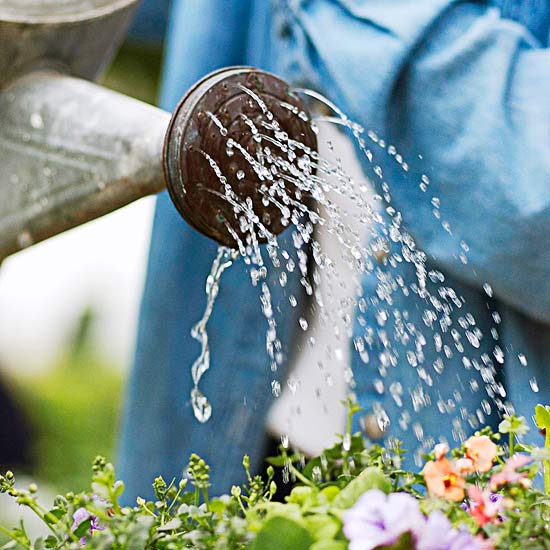






During dry spells, cut back on fertilizing. In dry conditions, fertilizer salts can dehydrate plant roots. Plus, the extra stimulus to put on growth that requires even more water.
Also: Adjust mowing height to the optimum level for your type of turfgrass -- usually 2-4 inches tall.
Learn more about watering your garden.
continue reading belowStrategically placed rocks look great and help direct water, slowing it down so it soaks into the ground and is more available for plants. Over time, rock installations will catch small amounts of soil and organic matter and create niches for plants to grow. Watch where the water runs when it rains, and place a small outcropping of various size rocks in its path. Bury up to a third of the rocks' surface for a more natural look. Learn more at harvestingrainwater.com.
Gray water is "gently used" household water, not sewage. Collect it by saving dishwater, filling a bucket while waiting for the shower to run warm, running a drain hose from your washing machine to trees outside the house, or even by installing a complete wastewater capture system. Check local codes for restrictions on using gray water. For more, go to caes.uga.edu and search under "gray water."
Water your garden in early morning, if possible. Temperatures are still cool and the sun is low, meaning you lose less moisture to evaporation. The way you water plants is important, too. Watering by hand can lead to runoff, and using an overhead sprinkler means more water is lost to evaporation. A drip irrigation system or soaker hose is best. Both are efficient and easy to use.
This is especially good with permanent plants such as trees, shrubs, and perennials. Temperatures are generally cooler, meaning water requirements will be less. While top growth slows, roots will be developing and getting established until the coldest weather comes. Plants will also benefit from winter snowfall or rains.
Dig compost into your soil to help hold moisture and encourage healthy root growth, then mulch the beds with an organic material such as wood chips. Mulch slows the evaporation of ground moisture and helps keep soil temperatures lower, reducing stress on plants. Also, natural mulches break down slowly over time, adding valuable organic matter to the soil. Research at Washington State University showed that wood chips were superior to herbicides in controlling weeds. Fewer weeds means less competition in your garden for available water.
Learn more about mulch.
One inch of rain falling on a 1,200-square-foot roof adds up to more than 748 gallons of fresh water! Instead of letting it run down the driveway and into the street, keep it for your thirsty plants. Use downspout attachments that direct the water into your flowerbeds. Or collect the water in a rain barrel, aboveground tank, or buried cistern for later use. Typical costs: $70-$200 for a rain barrel; $500-$600 for a 1,200-gallon aboveground tank; and $1,000-$1,500 for an underground cistern.
DIY Project: Make a Rain Barrel!
Look for plants that enjoy hot and sunny conditions. Cacti and succulents are good choices, especially for containers, because they'll require significantly less watering. They take up water when it's available and do their growing and blooming then. When it's dry, they grow more slowly and conserve water in their own tissues. Many other shrubs and perennials have adapted to environments with prolonged dry spells. In addition to your local nursery, sources for drought-tolerant plants include mail-order suppliers High Country Gardens and Plants of the Southwest. Both provide water-use symbols in their plant listings.
Discover top drought-tolerant perennials.
Search for more drought-tolerant varieties in Plant Encyclopedia.
Copyright © www.100flowers.win Botanic Garden All Rights Reserved